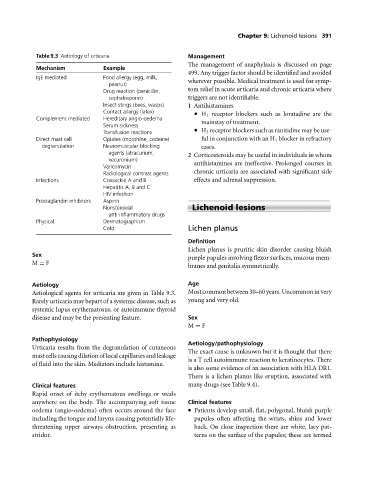Page 395 - Medicine and Surgery
P. 395
P1: FAW
BLUK007-09 BLUK007-Kendall May 12, 2005 19:59 Char Count= 0
Chapter 9: Lichenoid lesions 391
Table 9.3 Aetiology of urticaria Management
The management of anaphylaxis is discussed on page
Mechanism Example
499. Any trigger factor should be identified and avoided
IgE mediated Food allergy (egg, milk, wherever possible. Medical treatment is used for symp-
peanut)
Drug reaction (penicillin, tomrelief in acute urticaria and chronic urticaria where
cephalosporin) triggers are not identifiable.
Insect stings (bees, wasps) 1 Antihistamines
Contact allergy (latex) H 1 receptor blockers such as loratadine are the
Complement mediated Hereditary angio-oedema mainstay of treatment.
Serum sickness
H 2 receptor blockers such as ranitidine may be use-
Transfusion reactions
Direct mast cell Opiates (morphine, codeine) ful in conjunction with an H 1 blocker in refractory
degranulation Neuromuscular blocking cases.
agents (atracurium, 2 Corticosteroids may be useful in individuals in whom
vecuronium)
Vancomycin antihistamines are ineffective. Prolonged courses in
Radiological contrast agents chronic urticaria are associated with significant side
Infections Coxsackie A and B effects and adrenal suppression.
Hepatitis A, B and C
HIV infection
Prostaglandin inhibitors Aspirin
Nonsteroidal Lichenoid lesions
anti-inflammatory drugs
Physical Dermatographism
Cold Lichen planus
Definition
Lichen planus is pruritic skin disorder causing bluish
Sex
purple papules involving flexor surfaces, mucous mem-
M = F
branes and genitalia symmetrically.
Aetiology Age
Aetiological agents for urticaria are given in Table 9.3. Most common between 30–60 years. Uncommon in very
Rarely urticaria may bepart of a systemic disease, such as young and very old.
systemic lupus erythematosus, or autoimmune thyroid
disease and may be the presenting feature. Sex
M = F
Pathophysiology
Aetiology/pathophysiology
Urticaria results from the degranulation of cutaneous
The exact cause is unknown but it is thought that there
mast cells causing dilation of local capillaries and leakage
is a T cell autoimmune reaction to keratinocytes. There
of fluid into the skin. Mediators include histamine.
is also some evidence of an association with HLA DR1.
There is a lichen planus like eruption, associated with
Clinical features many drugs (see Table 9.4).
Rapid onset of itchy erythematous swellings or weals
anywhere on the body. The accompanying soft tissue Clinical features
oedema (angio-oedema) often occurs around the face Patients develop small, flat, polygonal, bluish purple
including the tongue and larynx causing potentially life- papules often affecting the wrists, shins and lower
threatening upper airways obstruction, presenting as back. On close inspection there are white, lacy pat-
stridor. ternson the surface of the papules; these are termed

